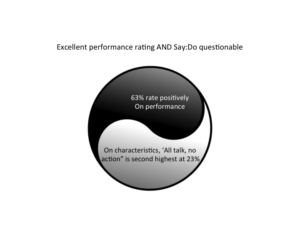One Ratio to Track for Success

Say:Do
Every quarter, companies that do not meet their stated projections, see their share prices go south immediately.
When politicians do not deliver, they are shown the door.
People speak disparagingly about colleagues, associates, friends and family who say a lot but do very little. As they do about service providers who fail to deliver on promises.
At the heart of any relationship lies trust. And a major factor in building trust is the faith that the other will do what they have said they will.
1 or <1, The ideal Say:Do ratio
So do individuals and organisations have to deliver all the time on their commitments?
Let’s unpack this a little more.

- Intent – When you say what does it mean to you? Is it a commitment, a wish or just words? The degree of effort that will go into do is directly related to intent. Will you really run every day or just think it’s a good thing to do or saying it for effect?
When an organisation says ‘belief in diversity’ is one of its values, is it the ‘correct thing to say’ or does it believe in it enough to lose money to live this value?

- Setting Expectations – ‘Delivery within 24 hours or your money back’ is an absolute commitment. ‘We will try and give you a sea-facing room, subject to availability’ sets the expectation totally differently. Seasoned professionals will tell you that a key to a great customer experience is to under commit and over deliver. Your Say:Do ratio will be <1.
P V Sindhu said ‘This time the colour of the medal will be different’, before she started her world championship campaign. It would have been great, if she had got gold but she did get silver, which was better than the bronze she had won so far. Which brings me to the next point.

- Stretch or New – Sometimes we state we will do something that is audacious or out of the ordinary. It is important that the stakeholders understand that this is indeed so. Stamping out corruption from our society within 10 years would be an audacious goal where people are likely to cut you some slack. If you had a Say:Do at 100:70, it would be fine. People will understand that you would not even have got there if you did not have the Intent.
On the other hand, ‘we will put15 lacs in your account within 5 years from black money recovered’ may be something where the expectation will be 1:1.
Elon Musk has ventured into never before territory. He is not meeting his sales projections. His investors have not lost faith as yet. They are only watching if he is doing things right and keeping the faith. They may all lose money. Sometimes there are risks associated with venturing into new, unexplored areas and again what is important is the Intent and the Effort.

- Effort – There are those who wonder how can something like demonetisation, which is an abject failure economically, yield electoral returns? Even if all the data were able to conclusively prove that it was a disastrous decision, my belief is it will still be seen as a positive effort in the commitment to eradicate black money. It is much the same for an Elon Musk or Flipkart.
It will be much the same if you, with two left feet, say you want to win ‘best dancer’ in this year’s Christmas party. Did you try to learn; is there a semblance of two different feet?
How you can use Say:Do to make changes
In my work as a Coach to organisation leaders, I use a method that is part of the Marshall Goldsmith Stakeholder Centered Coaching process. Once a leader identifies an area of behavioral change, we ask them to share it with their key stakeholders. “I am going to be a better listener. Watch me!â€
These are usually successful people who need to get better at something. By making them commit we are asking them to make sure their Say:Do ratio is 1 or <1. Research has established that this method has significantly higher chance of success than when it is not shared with stakeholders.
You could use the same principle for something where your intent is 100%. Try sharing your ‘say’ with your key stakeholders and ask them to give you feedback on your ‘do’.
Footnote
In a recent Mood of the Nation Survey by India Today there is a very interesting paradox that many have commented on.

63% respondents have rated the current PM’s performance as good or outstanding. This is down 6% since the last survey but still overwhelmingly good.
On a question about style of functioning, the second highest rating (23%) was for ‘All talk, no action’. The Say:Do ratio is tending towards the negative zone. I am sure this has not gone unnoticed.

 D5 Creation
D5 Creation